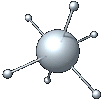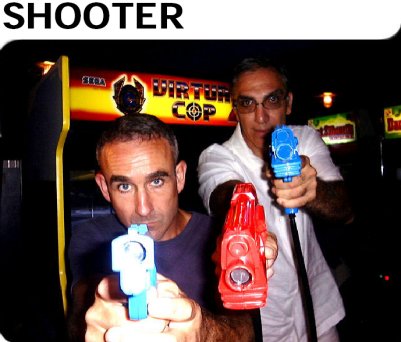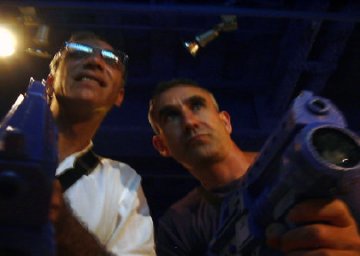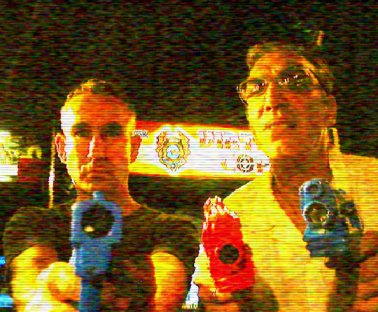
 |
 an interactive immersive sound installation by G.H. Hovagimyan and Peter Sinclair |
report by
G.H. Hovagimyan |
|
INTRODUCTION Peter Sinclair and I had been working on a new piece called "Shooter," and the proposal for the work was chosen as part of a pilot Artist-In-Residence program instituted by Eyebeam in New York City. The completed work was exhibited at Eyebeam as part of a group show titled Beta Launch that opened on October 16th 2002. The piece is a continuation of Peter's and my previous collaborative works, A SoaPOPera for Laptops/iMacs and Heartbreak Hotel. The premise of the piece are the psychological thresholds one passes through when engaging in a video/computer game. At first, there is the seduction or enticement to play when the player becomes engaged; there is immersion in the event structure; and finally there is the end of game, which, in many cases, means losing the game. |
| MEANING AND INTENTION
Shooter focuses on the issue of violence from the microcosmic level of gaming to the macrocosmic one of war, especially information war. It is an anti-war piece. It addresses the propensity for violence and the education of youth into a cartoon surrogate violence. In the 21st century, combat troops are being trained using all sorts of computer generated simulators. This is an escalation of the standard practice of dehumanizing the enemy. In the 21st century, warfare is simply a live reenactment of a video game. Make no mistake, the will to hatred and moral certitude is deeply embedded in the human psyche. Peter and I have discussed these parameters and attempted to load them into the work. When you are a child, parents classify your behavior as good boy / bad girl, bad boy / good girl. These are lessons you learn first, they shape your world view. They enable you to hate. They give you the moral certitude to justify any otherwise despicable action under the guise of righteousness. The escalation of this into an abstracted gaming reality is chilling. I am killing people but it doesn't matter because it is only a game. Or vice versa, I enjoy killing people because it is just like my favorite video game. The technology of hate and war is constantly being refined around the globe. The promise of global mass media and the global village envisioned by Marshal McLuhan has turned into an Orwellian nightmare of news-speak and double think. The neutral technological instruments of mass media and telecommunication are being used to induce a will to war. Think about the endless Al Jazeera newscasts of Palestinians beset upon by Israeli troops under the guise of impartial reporting. This is having an effect, just as the 24-hour news cycle in the US depends upon keeping fear of terrorist attacks a front and center way to garner audience for commercial television. Information technology has unleashed the dark demon of human paranoia and xenophobia worldwide and turned it into a gaming interface. |
I am killing people but it doesn't matter because itís only a game. Or vice versa, I enjoy killing people because it is just like my favorite video game. The technology of hate and war is constantly being refined around the globe. |
| SOUND SPATIALIZATION
The public is marginally aware of sound spatialization. They encounter Dolby surround sound when they go to the cinema. Usually, Hollywood movies go for cheap thrills and have scary sounds come up from behind you. One of the more interesting uses of surround sound in the cinema is the Alien Bar sequence in the Star Wars movie. Various sorts of alien voices are distributed through multiple channels to give you the feeling of being in the environment. Peter and I have worked with the French National Center for the Creation of Music known as GMEM (Group Musique Experimental de Marseille) and are using their Holophon sound spatialization software to create the eight channel sound spatialization environment for Shooter. The developer of Holophon, Laurent Pottier who is part of the GMEM staff, created a specially designed cubiform sound space for the Shooter piece. This allows us to place eight loudspeakers in a room, one in each of the eight corners. The cubiform sound space means we can move sound around the space on any of three axes -- East-West, North-South and Up-Down. The classic example is the sound of a fly circling around your head. The Holophon programming environment is integrated with MAX cycling 74 programming environ - ment, allowing us to create a database of sounds that are triggered by midi input sensors. In the case of Shooter, we are using lasers as the constant signal directed to photoelectric cells. An iCubeX interface completes the intermediate step between the laser and the computer. When a beam is interrupted, it triggers a sound file. THE ROOM Most interactive and digital works incorporate sound. Generally speaking, museums or gallery envi-- ronments are ill-suited to the presentation of sound works due to the poor acoustics of such spaces. In a group exhibition where more than one piece uses sound, this can pose quite a problem. The only good way to present these works is to build a sound-deadened room. In the US, the solution has often been to present works that use sound in a club or theater venue. Even if sounds works are chosen for exhibition in a gallery or museum, they are usually presented by giving the public a set of earphones to put on their heads in the exhibition space. More ambitious works are presented as performances. This may relegate sound works to a secondary status as a form of entertainment and ignores the issue of sound as a sculptural entity. As a sound artist, Peter has grappled with this problem more than once. For our previous work , Heartbreak Hotel, Peter and I came up with a design for a transportable soundproof chamber, which worked quite well and functions as a sort of art object. For Shooter, we took a different tact and asked for a soundproof room to be constructed. Aaron Campbell, who is the exhibition designer for Eyebeam, designed a room that fit our request and was integrated into the overall exhibition design. This might be a suitable approach for museums planning to show digital works that utilize sound. |
| THE INTERFACE
The meat of the physical interface for Shooter is the structure created by the web of laser beams interlacing the physical space. Each beam has a starting point and a receiving point. If the beam is broken, a sound file is triggered. Since laser light is directed light, it can be bounced around by mirrors to a final receiving point. Peter and I decided to build a mirrored cube that stands on a pipe pedestal at waist height in the center of the room. The cube has holes on each surface for the lasers to project out and return. Other mirrors are attached to the surface of the room's walls, allowing the light to be directed and bounced off the mirrored cube's surface. All the various wiring for the interface is contained within the cube and the pipe pedestal. The interface is also easily transportable and reusable and allows us to finetune the way in which a person will interact with the piece. We can create differing densities of the laser lattice, which ties the sounds and their intensity to the users' movements. |
 THE WORK THE WORK
The intention of the piece is to lead the person entering the work through a series of realizations. The inspiration is the common form of first-person shooter games, the basic framework of the bulk of computer games. In a standard first-person shooter, you have a weapon, and your point of view is that of the shooter. Your goal is to shoot as many of the aliens or enemies as you can in order to rack up points and win. Our Shooter game takes a different approach: upon entering the space, you hear the ambient sound environment of a gaming arcade. We recorded the samples at the Broadway Arcade on 42nd Street in New York. This is the 'seduction': when the person entering trips a laser, they become immersed in a game environment. The sounds we have in the database are of various levels of aggressivity. One set is of a menacing dog that circles around your feet, barking, snarling and snapping its teeth. Another set is of different types of gun sounds, from small arms fire to full scale mortar barrage. A fourth set is custom-designed game sounds. The person in the room quickly realizes they are not the shooter, they are the target. A third set is both Peter's and my voices speaking about the realities of violence. I approach this as a type of performance art. Peter has recorded about an hour of my ranting and reduced it to sound samples. He then responds to my rants by doing his own raps that are of a different voice and point of view. The result is a collaborative discourse between the two of us. A content jam if you will, or perhaps a call and response. These voice sample are then added onto the other sets through a sound morphing software that transfixes voice to gunfire or rant to dog growl. As the person approaches the cube interface in the center of the space, triggering of the sound files intensifies.  CONCLUSION CONCLUSION
The texture and psychology of war and violence is becoming yet another abstracted set of meta-lingiustic parameters fed into the media machine of global information. There is an increasingly fuzzy borderline between gaming violence, television violence, and the internalized human will to power cited by Friedrich Nietzsche. Instead of teaching a person to discipline and control their base urges, the thrust is to indulge in and act out these urges in an digitized virtual world, to experience brutality without the physical consequences. Yet, there is but one step from virtual to real. Scratch the surface of any civilized human and the savage lurks just beneath. Itís difficult as an artist to try and work with these issues without resorting to one or another trite position. To protest against violence and brutality within art is exemplary and normal. To deal with the underlying emotions and root causes is more difficult. To unveil the human penchant for ferocity within a construct of art is not the norm. Yet artists must neccessarily reflect the times in which they live. At the time of this writing, the George W. Bush White House has set up an incredible information juggernaut to convince the US population and the world that the US should attack Iraq. What is astounding is the level of discussion, precipitated by that political information machine, among the expanded cable and broadcast TV news shows. It is to some extent the extension of mass media as propaganda weapon but, more chillingly, as a way to convince the world of the inevitability of a war with Iraq. This type of heightened anticipation keeps people watching the news and, while they are at it, all the commercial sponsor advertising that surrounds the news reports. In the new monetary climate of war profiteering, the TV news programs are the winners. Let me rephrase this, the money to be made from war and suffering will not only come from the manufacture of weapons but also from the advertising dollars spent to have commercials positioned during news broadcasts. War fever creates anxiety. Anxiety translates into a need for information. Advertising foots the bill. We are moving into a virtual world of mediated violence that is enacted in order to be interpreted. The 'players' are not only the men who go to war and the generals and politicians who promote, nay relish such actions, but also the media vehicles that present violence as an hourly dose on the screens of televisions and gaming terminals. Who among us can say that the visceral enjoyment afforded by the limbic stimulants of fear, anger, xenophobia and hatred isnít what we really desire? These depth archetypes are the basis for the overwhelming popularity of Shooter style games. One may fantasize a rosy science fiction future, where virtual war conducted in gaming simulations will replace the real thing. But is that what we really want? Do we want to indulge our savagery in spirit if not in flesh? And what of the opposite reality? The absolute physical reality of pain, suffering and death. It exists and yet, unless it happens to us directly or to someone close to us, we are hardly effected. Even a suicide bomber has a mediated persona embodied in a prosaic videotape of the hero stating his/her resolution before the act. They have passed to some other reality, an ancient dream of heaven and nirvana burned into the collective mythos of the global information reality. |